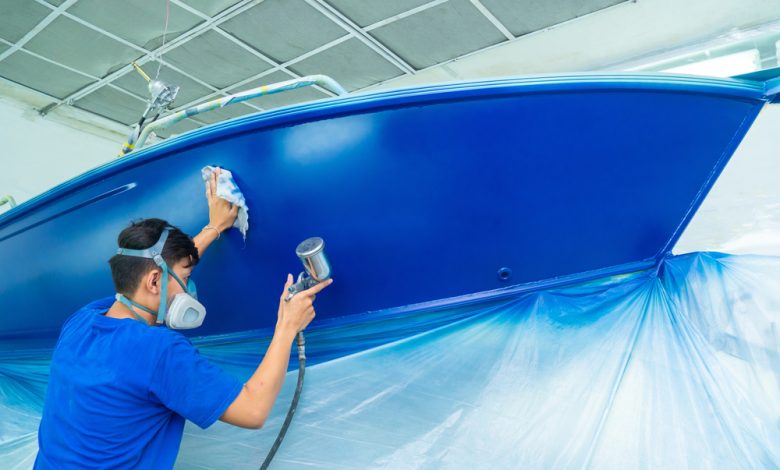Boat Painting 101: Tips for Application and Preservation

For a lot of watercraft owners, boat painting is a challenging task. But how to repaint a boat is harder. But in this article, we made it simpler so owners can make their vessels appear new again if you want to restore them.
To keep your personal watercraft looking its best, you need to know how to retain the paint on a boat and to keep it looking its best. Even though painting a boat takes time and money, there’s no better method to restore a dirty watercraft to its former glory.
What’s Causing My Boat’s Fresh Coat of Paint to Peel and Flake Off?
Mother Nature is the biggest culprit when it comes to maritime paint degradation. In both fresh and saltwater, your boat is exposed to severe inclement weather that may damage the paintwork, regardless of whether you’re a fresh or saltwater sailor.
-
The Sun’s Rays
The sun’s dangerous UV rays may damage the paintwork of your yacht in the same way that scorching heat can burn your skin if you are outdoors for an extended period without sufficient protection.
-
Salt
Inevitably, your boat will be exposed to a great deal of saltwater if you often take it out on the open ocean. Repeated exposure to the salty air and water may lead to paint discoloration and even structural oxidation in the boat.
-
Too Much Polishing
There is no shortage of elbow grease involved in making our boats look their best while they’re out on the water. Our boats will appear better, but the paint will be thinner and more sensitive to the weather if we do this.
5 Tips to Improve Figurative Painting Skills
Ways to Paint Fiberglass Boat
Unless you’re using a specific kind of paint and paying attention to a few extra steps in the preparation and application process, painting fiberglass boats is quite similar to painting wood boats. Professionals who use a paint sprayer rather than a brush or roller may get the greatest results. Nevertheless, anybody may paint a boat with success if they pay attention to detail and follow the manufacturer’s instructions carefully.
Home Renovations: 3 Tips for Painting Your Home
Fiberglass Boat Paint
Paints that use just one component, such as single-part enamels, may be applied more efficiently and cost less than other paint alternatives. It’s not only that they’re vulnerable to UV damage; they also lose their shine with time, particularly if they aren’t routinely waxed and maintained.
Unlike two-part polyurethanes, single-part polyurethane paints are easier to apply, cost less, and maintain their sheen for longer.
The best-looking and longest-lasting paints are two-part polyurethane paints. Some individuals claim that they can even outshine the boat’s gel finish. The downside is that they are more costly and time-consuming to use since they need mixing, an epoxy primer, and precise temperature and humidity conditions for application.
Following the manufacturer’s instructions is the first and most crucial step in the process. Because each painting has its unique specifications, we cannot go into great depth about them all here. Although each has its own set of strict guidelines, the essential truth is that each is achievable with the correct application.
Remember that preparation is essential to a successful paint job, just as it is with any other. Even a minor quantity of wax may prevent paint from sticking to the fiberglass. Thus, de-waxing is a crucial step. Using acetone or a wax stripper is up to you; nonetheless, you should be thorough in your removal process.
Some interesting guidelines about spray painting in Sydney – top tips
Fiberglass Boat Painting Tips
It’s common for individuals to utilize the “roll and tip” approach when painting big parts of a boat’s exterior. Two workers and two rollers and brushes are needed for this task. To remove the roller pattern, have one person roll out the paint while the other follows after with a brush and softly brushes the paint.
If you want the greatest finish, use numerous coats of a thin consistency rather than a few thick ones. It is recommended that you use three coats of paint for optimal results.
Remember that appropriate curing time between layers (again, considering the manufacturer’s guidelines) is crucial. Additionally, keep an eye on the weather situation to ensure that temperatures and humidity levels are stable during the duration of your project.
3 Boat Buying Tips Every Aspiring Fishing Boat Owner Should Know
How to Paint the Underside of a Boat
When it comes to painting a boat’s bottom, it’s unique from painting the top hull and exterior siding. There are several antifouling paints to pick from in this situation, and you’ll need one that stops marine development.
- Preparation (de-waxing and sanding) is still required if the bottom is a new gel coat.
- Bypass the de-waxing step and remove old or loose paint instead if you’re boat painting over old bottom paint. Additionally, because the bottom of the vessel will be submerged, there is no need to roll and tip the paint. Most people roll the paint on.
- When painting the bottom of a boat, however, there is one more consideration to keep in mind: the timing of the boat’s launch. Paints with minimum and maximum drying time must be used within a certain period.
Six tips top painting tips for your very first paint.
How to Paint the Hull of a Boat
When painting a boat’s hull sides, you’re dealing with a big, smooth surface area, making it easier to paint the boat’s topside. You won’t have to worry about tilted surfaces or tight corners when removing hardware because you won’t have to deal with them.
However, one thing to remember when it comes to painting a boat’s hull: Applying paint too unevenly will cause drips and runs because you’ll be working on a mostly vertical surface. This means that you must apply the paint uniformly and delicately.
How to Apply Non-Skid Paint on a Boat
This means that you can’t paint molded fiberglass anti-skid and anti-slip decks as you would other parts of your yacht. Because the raised surfaces are so little, it’s hard to sand or paint around them, and even if you did color it, it would fade unevenly as people walked over it. Even so, it doesn’t imply that you can’t spruce up an old non-skid.
Applying a grainy compound is the best approach to make a surface non-slip and prevent slipping accidents. Boat deck paint is available in a variety of formulations. They use grit or small rubberized pellets in the paint for a fresh new appearance to keep the boat deck’s non-slip capabilities.
If you’re using any of these products, you should follow the application directions carefully since each has its unique characteristics.
You should also be aware of the roller, which is necessary since some paints contain solids and hence need a roller brush made particularly for spreading.
What Is the Best Way to Preserve the Paint on My Boat?
-Cover
The most common cause of marine paint deterioration, as previously stated, is exposure to the elements. Keep your boat as protected from the elements as possible to avoid this. Keep her in the shade, or get a boat painters cover to protect her if you can.
-Wax
Waxing may help keep paint from peeling and fading by preventing oxidation. At the very least, give your boat a complete waxing at least two times a year, and probably even more regularly if you take it out on the water frequently. Boat owners should use boat wax or marine wax instead of automotive wax for waxing boats.
Final Consideration
Keep in mind that many coatings, primers, and wax strippers produce toxic vapors, and sanding may also create potentially harmful situations for both you and the ecosystem. Always read the warning signs on all the materials before painting a boat, and wear the appropriate safety gear.




